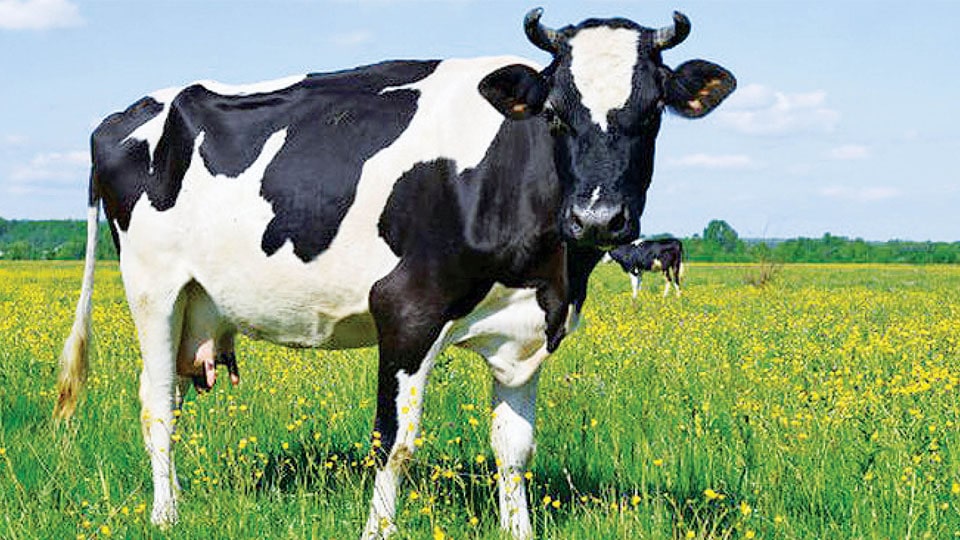In this week’s Pet Talk, Maneka explains how to keep surroundings around the cattle sanitised
By Maneka Gandhi
What do the movement and position of the tail mean in cattle?
The tail is an important signalling device in cattle. The tail will usually be held horizontal during defecation and urination. If, together with the head, it is elevated, this often indicates a desire to investigate the source of some stimulus. Tails are also elevated during oestrus display, fighting, threats, greetings, suckling and homosexual activities in both males and females. Conversely when the tail is held between the legs, this indicates the animal is cold or frightened or fearful. Lateral movements of the tail are often used for fly removal but can be a response to more general skin irritations such as rubbing or stimulation, such as of vulva or penis during sexual behaviour. Tail wagging is also common when cattle are being irritated. Cows will wag their tail as a threat if they are about to kick. Tail wagging can also be performed in response to painful stimuli.
How can you make aggressive cattle calm?
Use positive interactions such as a stroking or rubbing or resting the hand on the cow’s back.
Reduce excessive noise, such as banging gates and shouting. Avoid staring at a cow directly for long periods. Use slow and deliberate movement and talking.
What is the normal body temperature of a cow?
The normal body temperature for a cow is 102.5 degrees Fahrenheit.
How can you tell a cow is happy?
Closely observe the cows, a glossy coat means the cow’s getting good nutrition, and the roundness means the cow has good rumen fill. When you see the ridges on a cow’s abdomen, called happy lines, it’s the absolute best sign for a healthy, well-fed cow and a healthy and well fed cow is a happy cow — as long as you let her free to roam.
Do cows like to be petted?
Cows are social animal; thus Cows love to be petted, stroked and scratched behind the ears.
How do cows show affection to humans?
Cows are emotional animals who have likes and dislikes, just like humans do. Many cows are affectionate animals who are deeply loyal to their families and human companions. Cows can use their body posture and vocal sounds to express a whole range of emotions, including contentment, interest, anger and distress. Whenever in distress or pain, cows moo to express their emotion.
Are cows intelligent?
Cows are very intelligent. Cows are extremely intellectually complex beings that rely on not only their own decisiveness but that of their companions too. Numerous scientific case studies have concluded that cows understand the mechanism of a complex cause-and-effect relationship; a cow that has tendencies to graze with another cow for periods of prolonged time will become a friend, whereas a cow that has been bullied by another cow will have the ability to identify the individual and hold a grudge (if need be) against said ‘mean cow.’
Do cows show affection?
Cows are emotional, social animals who make and keep best friends, love physical affection, show an appreciation for music, and are deeply curious about other creatures and the world around them.
Do cows get emotional?
They experience a wide range of emotions. For example, they display fear and anxiety and the less eye white that is seen, the better they feel. When cow mothers are separated from their calves, they experience great amount of pain and they express it by mooing.
What are some common disinfectants and their usage which help in keeping the surroundings around the cattle clean and sanitised?
Bleaching powder (Chloride of lime). It can be used for disinfection of cow shelter when a contagious disease has occurred and for sterilisation of water supplies. Bleaching powder must be stored in airtight bins, as damp surroundings, exposure to light and air causes it to decompose rapidly. Boric acid can be used as an udder wash. It is used as wash for eyes and other sensitive parts of the body. Concentration required is 6 percent solution. Mode of application is splashing. Nowadays antibiotic solutions are replacing boric acid as eyewash solution.
Caustic soda (Sodium hydroxide) is for general use in farm buildings and animal houses. It is a powerful germicide. It is highly destructive to virus of foot and mouth disease etc. Concentration required is 2 percent solution for general use and 5 percent solution against spores of anthrax and black quarter. Mode of application is splashing.
Rubber gloves, goggles and protective clothing should always be worn when caustic soda solution is being used, as it burns skin and damages fabrics.
Soap is a very week germicide. Its great usefulness is in cleaning skin. It can be used preparatory to the application of a disinfectant. Mode of application is scrubbing.
It should be used only as surface-sanitising agent.








Recent Comments